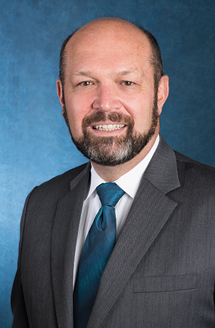May 2016—I received a number of letters about last December’s column on the late Oliver Sacks, MD, who wrote with great insight about his experience with a tumor-induced scotoma. One of the most moving came from a seasoned medical professional who had survived traumatic brain injury.

Richard C. Friedberg, MD, PhD
Learning how to overcome challenges resulting from the trauma by “rewiring” the brain had been “remarkable and enlightening,” my correspondent said. Astute, succinct, and generous, I thought. The next sentence in the letter impressed me even more—a reminder that our first concern must always be what is best for our patients.
For the most part, we think of our laboratories as workplaces rather than settings where high-tech, scary tests lead to life-changing diagnoses. This letter reminded me that for many of our patients, hospitals are foreign environments in which they may endure difficult treatments that make little sense to them but promise much of the hope of healing. As my correspondent made plain, every one of us has an intimate role in that healing. When viewed through a patient-centric lens, the medical laboratory is a highly dynamic place.
We know that the finest staff in the best laboratory can always do better, which is why accreditation in the form of external validation by peers is so important. Continuous quality improvement means change, which means uncertainty for many and visceral discomfort for others. However, I can take solace in the recognition that those butterflies in the stomach are transient. I have learned to welcome feelings of unease as reliable harbingers of good things.
The legacy of Sidney Farber, MD (as described in The Emperor of All Maladies: A Biography of Cancer by Siddhartha Mukherjee, MD), is a good example. Upon completing training in 1929, Dr. Farber became an instructor in pathology at Harvard Medical School. Only one year later, he became the first full-time pathologist at Children’s Hospital in Boston. He established programs of teaching and research on childhood disorders at both institutions. Eventually, he became chairman of the Division of Laboratories and Research at Children’s Hospital and pathologist-in-chief at Harvard Medical School.
When Dr. Farber entered practice, a diagnosis of pediatric leukemia was a short-term death sentence. It was a diagnosis he had made too often for too many years, and he was determined to figure it out. His clinical involvement grew over time until he was able to persuade skeptical colleagues to permit a trial of folate administration in these patients in the hope of stimulating healthy cell growth.
The results were tragically disappointing, exacerbating already substantial resistance to the project, Dr. Mukherjee writes, but Dr. Farber had become deeply committed to the work. Rather than abandon it, he set out to test an alternative hypothesis: that a folate antagonist might slow cancer cell proliferation.
In 1948, Dr. Farber and colleagues published a landmark paper in the New England Journal of Medicine describing children with acute leukemia in whom a folic acid antagonist had produced temporary remission. Seven years later, he pioneered the combined use of chemotherapy and radiation for children with solid tumors. Dr. Mukherjee describes Dr. Farber leading rounds each evening with residents, nurses, social workers, psychiatrists, nutritionists, and pharmacists, promoting a multidisciplinary approach that he called “total care.”
Dr. Farber was a classic pathologist: intent upon seeking research-driven solutions to the problems he saw, creative and intuitive in his approach, faithful in pursuit of avenues that others thought futile. Like many inclined toward research, he worked alone at the start and matured to become a successful advocate for cancer research funding. The Sidney Farber Cancer Center (now Dana-Farber Cancer Institute) in Boston was named for him.
Twenty years ago, my 92-year-old English grandfather died from metastatic prostate cancer. For many in his generation, the term “cancer” was typically whispered, a symbolic fear of spreading the disease itself. In those days, many patients in the U.K. were not told of terminal diagnoses; my grandfather learned the cause of his pain only 30 minutes before he died. Today, my grandparents might have been asked to consider active surveillance with minimal biopsies to enable timely intervention. His pathologist and oncologist might have met with them to explain their options and monitored his progress. That would have been a privilege—a privilege that many of us may know, if circumstances warrant, in years to come.
Some say that we know more in medicine than we know what to do with, and there is something to that. As diagnosticians, we know better than most that while intuitive insight may be a solitary endeavor, effective application of new knowledge is most often collaborative. Increasingly, acute illnesses are becoming manageable chronic diseases, a trend that will continue. We may find, like Dr. Farber, that our knowledge confers a duty to educate and advocate for our patients. Only those who know can teach.
Dr. Mukherjee writes that Dr. Farber was something of a loner early in his career, deeply immersed in his research. I doubt he would have enjoyed appearing before citizen groups to present the case for funding to study cancer or testifying before Congress to secure it. Yet he found a way to step outside his comfort zone, and in so doing he gave us the courage to pursue new avenues of inquiry that have saved countless lives. Dr. Farber was a true pathologist—a scientific talent with the heart of a clinician.
Dr. Mukherjee will be a featured speaker at CAP ’16, which will be held Sept. 25–28 in Las Vegas. We’ll talk about special events and plenaries next month. In the meantime, online registration is open and the first 160 registrants will receive a copy of The Emperor of All Maladies. Please make plans to join your partners and peers.
[hr]
Dr. Friedberg welcomes communication from CAP members. Write to him at president@cap.org.